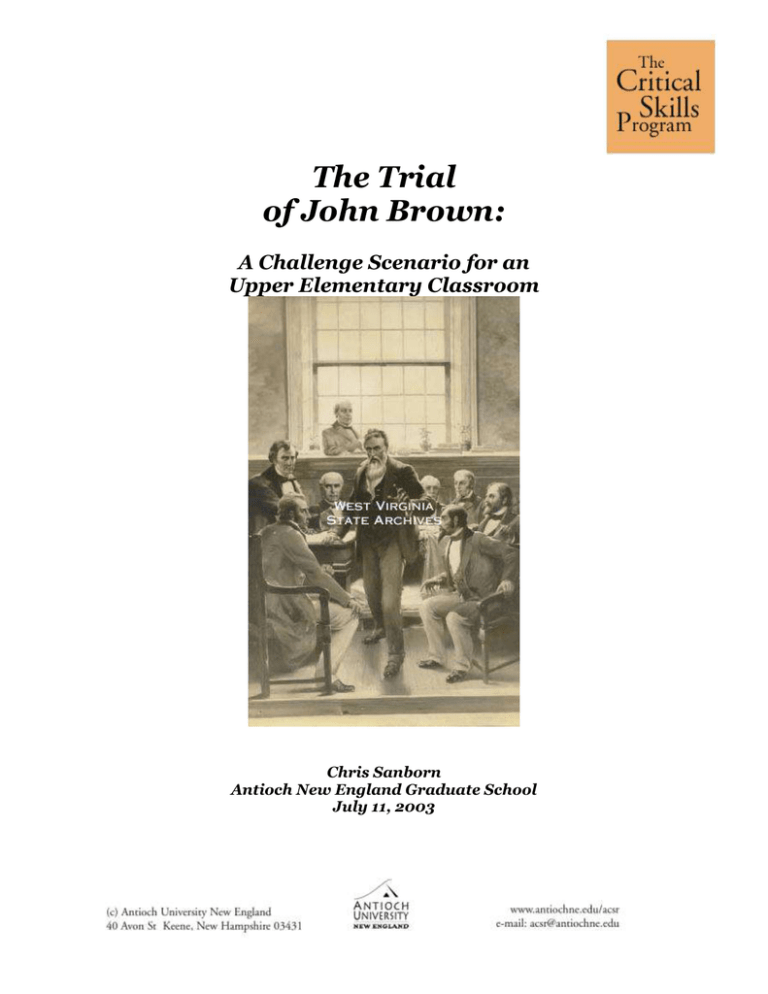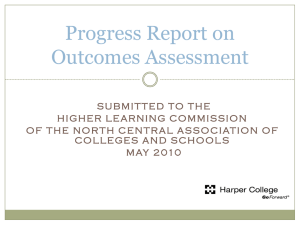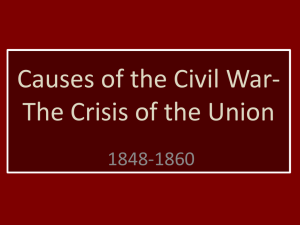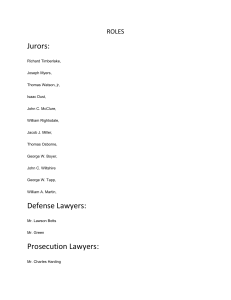The trial of John Brown
advertisement

The Trial of John Brown: A Challenge Scenario for an Upper Elementary Classroom Chris Sanborn Antioch New England Graduate School July 11, 2003 The Trial of John Brown: A Challenge Scenario In 1859, prior to the onset of the American Civil War, a Massachusetts man named John Brown conducted a raid on Harper’s Ferry with the intention of freeing the slaves and creating a state free from the institution of slavery. The raid became violent, Brown was arrested, and in November, 1859, John Brown’s case was put to trial in Charlestown, Virginia. His crusade against slavery is a spark that ignited the Civil War. The story of John Brown is an essential piece of American history that is controversial, often misunderstood, and misrepresented in history classes and textbooks. As specialists on this period of American history, the Harper’s Ferry National Historical Park (HFNHP) has hired you as actors and actresses in the Civil War re-enactment team. In order to provide the public with an understanding of the characters, events, and issues involved in the raid on Harper’s Ferry and the ensuing trial, the HFNHP has asked our class to reenactment The Trial of John Brown on May 15, 2004 in the Center Auditorium. An audience of community members, parents, staff and students will be present to provide feedback on the reenactment. In preparation for the trial, the members of the HFHS will divide itself into three teams: the Defense, the Prosecution, and the Jury. Each team member will share responsibilities for researching the opinions and testimonies of the case, communicate effectively with group members, and use in-class and out-of-class time wisely. The Defense and Prosecution teams must choose three witnesses and one attorney to present their side of the case. The courtroom speeches and testimonies must meet the following guidelines: Clear beginning, middle, and end All facts and opinions expressed are historically accurate Issues are addressed and expressed clearly Speeches are persuasive and convincing Minimum 2 minutes long, with 2 minutes for questions Display oral presentation skills of tempo, volume, and clarity The Jury team will be expected to research both sides of the case and prepare a written summary of the facts, possible testimonies, and questions. Following the trial, each member of the jury will prepare written responses to the testimonies, come to an independent decision, and meet with the entire jury to come to a final group decision. A presentation of the final jury decision will be expected. The jury also serves as stage managers for the production. Is John Brown crazy or sane? Were his actions justified? Does he deserve the death penalty, or is he a national hero? You decide. Fifth graders, the course of history is in your hands! DISCUSSION / BACKGROUND: This challenge comes out of a personal affinity with the John Brown story. In history class, I learned that John Brown was a crazy, violent zealot with a head of fire and a heart of stone. Years later I discovered that my forefather, F.B. Sanborn, of Concord, MA, was a financial supporter of John Brown. My interest peaked and I looked deeper into this case. At a family dinner table conversation about John Brown one evening, we discovered that my mom’s ancestor (Sanborn) supported Brown and my father’s ancestor was the sheriff of Harper’s Ferry that had Brown hanged! I chose this topic as a possible final challenge for a class of fifth graders who are beginning to study the United States Civil War as stated in the Massachusetts Curriculum Frameworks (see attached Lesson Plan). It is assumed that the class would already have had experience with group collaboration, various types of challenges, and dramatic presentations. Using these skills, The Trial of John Brown is an opportunity to assess the culmination of skills learned throughout the year, including group collaboration, independent research, and oral and written presentations. Aside from my personal interest in this case, I believe it has much to teach in regards to the Civil War. I love to use moral dilemmas in classroom settings to inspire deep thinking and insightful discussions. The moral issues of proper treatment of our fellow humans (slavery) and the use of violent force (a slave rebellion) are perennial topics throughout the history of humans. These moral issues can be a hook into the fleshy body of history, allowing learners to form their own opinions about what actually happened and why. Through active involvement in team discussions, independent research, and impassioned courtroom speeches, the students will begin to find that they, too, can evaluate and participate in history. Another idea I had for presenting the challenge is to give each team a written letter from one of the key witnesses or personalities in the case. For example, the defense team would receive a letter from John Brown, detailing his reasons for the raid, and reminding the defense team of his personal background in religion, as well as other reasons that he should be considered sane and his actions justified. The prosecution would receive a letter from the sheriff of Harper’s Ferry who actually witnessed the raid and is urging them to prosecute the violent criminal, Mr. Brown, to the full extent of the law. If the challenge were to be presented in this manner, it would serve as motivation for the team’s purpose and provide a starting ground from which to devise a plan for courtroom presentation. My intention is to bring history to life by any means necessary. The Trial of John Brown DESCRIPTION This simulation, designed for fifth grade students experienced with challenges and group work, is an introduction to the pre-Civil War political climate in the United States. Through a recreation of the trial of John Brown, students will explore the moral issues of slavery and violence as a means to achieve a political and social objective. OBJECTIVES The students will: 1. Develop an understanding for the political and moral sentiments that led to the Civil War. 2. Collaborate and cooperate in the preparation for a final presentation. 3. Create and deliver persuasive arguments drawing on research and knowledge of the time period and the relevant issues. MATERIALS Internet Access, reference books Costumes, props, set SPACE & TIME CONSIDERATIONS The research will take place in the library and in the classroom. The final Mock Trial presentation will require a space large enough to serve as a courtroom. The entire process, including assessment, needs to be given eight classroom hours, plus homework time. PROCEDURE 1. Introduce challenge. Brainstorm ideas, questions, procedure, and assessment. 2. Students divide themselves into teams: defense, prosecution, jury. 3. Each team collaborates on responsibilities for research and presentation. 4. Rehearsal is held prior to Mock Trial. 5. Final presentation: speeches, rebuttals, feedback, and assessment. STANDARDS Massachusetts History and Social Science Curriculum Framework 5.34 Identify the key issues that contributed to the onset of the Civil War. Massachusetts English Language Arts Curriculum Framework Reading and Literature Strand GENERAL STANDARD 18: DRAMATIC READING & PERFORMANCE Students will plan and present dramatic readings, recitations, and performances that demonstrate appropriate consideration of audience and purpose. Rehearsal and performance involve memorization and the use of expressive speech and gestures. Because of their repetitive nature, they demand of student actors a level of active engagement that surpasses that of reading. The excitement and satisfaction of performing in front of an audience should be part of every student’s school experience. 18.2 Plan and perform readings of selected texts for an audience, using clear diction and voice quality (volume, tempo, clarity) appropriate to the selection, and use teacher-developed assessment criteria to prepare presentations. Grades 5 and 6 – COMPOSITION, Standards 19 and 24: Writing and Research Apply steps for obtaining and evaluating information and presenting research, including using an expanded range of print and non-print sources, following established criteria for evaluating information and locating specific information using indexes, tables of contents, and electronic search keywords, and providing documentation in a consistent format. Massachusetts The Arts Disciplines Curriculum Frameworks Pre K–12 Standard 1: Acting Students will develop acting skills to portray characters who interact in improvised and scripted scenes. 1.3 Pretend to be someone else, creating a character based on stories or through improvisation, using properties (props), costumes, and imagery 1.4 Create characters through physical movement, gesture, sound and/or speech, and facial expression 1.5 Learn lines, observe, listen, and respond in character to other actors 1.6 Demonstrate the ability to work effectively alone and cooperatively with a partner or in an ensemble Dramatization When students plan and dramatize scenes from a story, they are translating one genre or form into another. Through dialogue and movement, they show their interpretation of literary elements such as plot, character motivation, conflict, and tone without using the abstract vocabulary of literary analysis to communicate their insights. Clear criteria for performance help students focus on elements such as pacing, volume, use of gestures, and expressiveness. CRITICAL SKILLS and DISPOSITIONS Organization Communication Collaboration WEB RESOURCES http://www.nps.gov/hafe/home.htm The home page of the Harper’s Ferry National Historical Park, complete with photos of John Brown’s fort; transcripts of the Mauzy Letters on John Brown’s Raid; an interview with author and historian Stephen B. Oates – a must for use in the classroom; and a description of John Brown and the Harper’s Ferry raid. www.pbs.org/wgbh/amex/brown “The American Experience: John Brown’s Holy War.” This is an overview of the PBS film, complete with a timeline, maps, interview transcripts, primary source documents, and classroom activities. http://jefferson.village.virginia.edu/jbrown/master.html “John Brown and the Valley of the Shadow,” a page which includes eyewitness accounts of the raid, trial and hanging; newspaper articles from the time period; pictures of supporters, characters, settings. http://wvmemory.wvculture.org/imlsintro.html “John Brown / Boyd B. Stutler Collection Database,” a new electronic database from one of the most important collections pertaining to John Brown. Over 100 original letters from John Brown and his supporters, pictures of people and places, and access to copies of the original documents are available on this website. This site is HUGE, comprehensive, and invaluable! http://www.nationalcenter.org/JohnBrown'sSpeech.html The full text of John Brown’s Speech to the court at his trial, November 2, 1859. BOOKS "The Legend of John Brown: A Biography and a History," by Richard O. Boyer "His Soul Goes Marching On: Responses to John Brown and the Harpers Ferry Raid," edited by Paul Finkelman "To Purge This Land With Blood: A Biography of John Brown," by Warren Oates and Stephen B. Oates "The Secret Six: The True Tale of the Men Who Conspired With John Brown," by Edward J. Renehan "John Brown, 1800-1859, A Biography Fifty Years After," by Oswald Garrison Villard The Trial of John Brown: An Assessment Oral Presentation Quality: WOW! Good Poor Volume 1 2 3 4 5 Tempo 1 2 3 4 5 Clarity 1 2 3 4 5 Oral Presentation Content WOW! Good Poor Clear Beginning / Middle / End 2 4 6 8 10 Addresses Topic Clearly 3 6 9 12 15 Historical Accuracy 2 4 6 8 10 Persuasive 3 6 9 12 15 Appropriate Responses to Questions 1 2 3 4 5 Group Process WOW! Good Poor Shares Responsibility for Research 2 4 6 8 10 Uses Time Wisely 2 4 6 8 10 Communicates Effectively with Peers 2 4 6 8 10 TOTAL SCORE:___________ NAME OF STUDENT:_______________________ NAME OF ASSESSOR:_______________________ DATE:_________________________ Created By: Chris Sanborn, Antioch New England Graduate School


